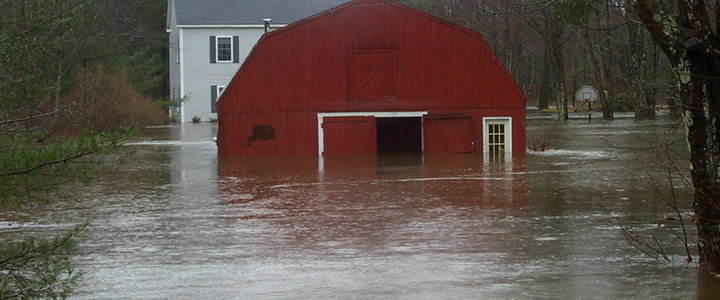
March 2023: Beware of Safety Hazards in a Flooded Home
Floods are the most common type of natural disaster affecting people across the United States, and New Hampshire residents must contend with it sometimes, too. Heavy spring rains, slow-moving summer thunderstorms, or the rare hurricane can come through and cause severe flooding nearly anywhere within the state. Floods can introduce new hazards inside and outside a home. Flood waters can carry sewage and other harmful substances indoors and standing water and wet materials can become a breeding ground for viruses, bacteria and mold.
There are many things to consider before you begin to clean up a flood-damaged home in order to promote safety as well as healthy indoor air quality. But before you even begin, take note of these two very important safety tips:
- Children, pregnant people, and people with weakened immune systems or chronic breathing problems like asthma should not help with flood cleanup.
- Never use a fuel-powered portable generator inside your home, garage, shed, or any enclosed areas. Always use generators outside and at least 20 feet away from buildings. Generator exhaust contains deadly carbon monoxide gas.
Returning to Your Home
Ideally, you would clean and dry your home and everything in it within 24 to 48 hours. However, before entering the home, be sure the structure is safe. You can look for things like roofs that sag in the middle or at the ends, walls that are not straight, missing support columns or new cracks in the exterior, but you really shouldn’t enter until it has been verified by a qualified professional as safe to enter. Remember that rebuilding can only begin after you get the required local permits to ensure your construction complies with local building codes and flood damage prevention ordinances.
Once you’ve determined it’s safe to enter your home, make sure the electricity is off to avoid shock hazards from standing water and potentially wet outlets.
Safety Gear and Tools
Things that have been touched by flood water can contain bacteria and mold spores. Wear protective clothes like rubber gloves, pants and sturdy shoes. When cleaning and removing mold, wear a face mask and goggles to keep out dust and small particles.
Other items for repair and renovation include a moisture meter, fans/dehumidifiers, plastic sheathing, shovel, a way to cut drywall, flashlight, first-aid kit, tools such as hammers and saws, drinking water, and trash bags.
Inspect Debris Before Cleanup
Once you get back inside, it’s time to start cleaning up and there are several things to consider:
- Removing standing water, mud and silt slowly to avoid the potential of making the walls or floor crack and collapse.
- Wall cleanup: Determine the hazards of lead-based paint before removing walls or cleaning up debris.
- Older homes, including apartments, may contain asbestos. Determine if your home may have asbestos-containing materials, before cleaning up any debris. If there is asbestos-containing material, hire an asbestos professional.
- Before refinishing and replacing walls and flooring, everything in the home needs to be completely dry to prevent future mold growth and to prevent materials from losing their structural integrity.
- While cleaning, ventilate and dry your home by using fans and dehumidifiers and opening doors and windows. However, if you can already see mold, do not use fans because they can spread it. Call in a professional to treat or remove the mold.
View this EPA illustration on where to find hazards in your home. NHDES also provides a detailed fact sheet on how to manage most collected debris after a storm event.
To Trash or Not to Trash
Generally, most household items made of metal, plastic or ceramics, like silverware and dishes, can be cleaned up and kept, while other things like wood furniture, photos and books, clothing, and appliances may need to be disposed of depending on the level of damage. You can clean hard surfaces with detergent and water. Do not mix cleaning products together or add bleach to other chemicals. There are some items that the EPA recommends you dispose of if flood-damaged:
- Mattresses.
- Leather, wood veneer or cloth-upholstered furniture.
- Cushions and pillows.
- Medicine.
Renters may need to see if their items were covered by renter's insurance. Always make sure to take pictures of your items before throwing them away. Talk to your landlord about your rental agreement if your apartment has been flooded.
Before bringing your items to a facility or putting on the curb, contact your local solid waste facility or hauler to determine if there are additional steps you need to take before they will accept those items.
More Information
Visit EPA’s new Flood Cleanup to Protect Indoor Air and Your Health webpage for more information on actions you can take after a flood, which includes step-by-step videos that explain the process.




